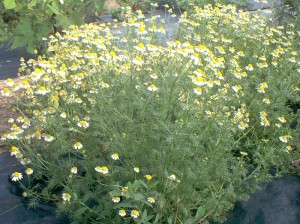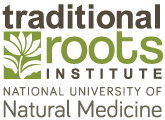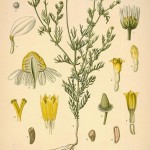“….. Peter was not very well during the evening. His mother put him to bed, and made some chamomile tea and she gave a dose of it to Peter.” ~ from The Tale of Peter Rabbit by Beatrix Potter (England, 1901)
 History
History
Chamomile is one of the more familiar medicinal herbs, with a high profile in literature and a long history of use. This plant’s popularity is well-deserved.
Chamomile’s earliest recorded use goes back much further: according to the Eber’s Papyrus, dated to 1550 BC, ancient Egyptians used the herb to honor the gods, embalm the dead and cure the sick. In Europe, medicinal use of Chamomile has been recorded since the 1st century AD. Today, Chamomile remains a top-selling herb in the tea market place.
Uses
So what is chamomile good for, anyway?
As a complex living medicine, herbs cross body systems to provide us with just the support we need. With Chamomile, the gentle flower’s actions are centered on calming and decreasing inflammation. Chamomile is calming to both the nervous system as well as the digestive system. Indeed, one of its primary uses is in soothing the digestive tract, especially when stress is contributing to the upset (see Remedying Overeating & Holiday Strain for more details) . Chamomile is great (as part of a formula, or on its own) for irritable bowel flare-ups. It is gentle enough for kids, and has a long history of use not only for stressed-out bunnies, but also upset children with tummy aches.
Homeopathically, and as a tea (at room temperature or in ice cubes), Chamomila is the number one remedy for teething, especially for babies whose distress seems out of proportion to the pain, and where one cheek is red while the other is pale. Studies prove that it is healing to gastrointestinal ulcers. It is also a much-appreciated part of skin-healing formulas, from soothing rashes to healing tattoos to preventing ingrown hairs after waxing or shaving. The essential oil in chamomile, azulene, is much-studied for its anti-inflammatory capacity, and is remarkable also for the fact that this oil is bright blue!
The herb is also antimicrobial, having an effect on both fungi and bacteria, making it broadly useful for topical and internal infections, especially in the gastrointestinal tract. Most commonly, perhaps, chamomile is used as a tea for relaxation.
What could be better in the evening than a cup of tea that helps you to unwind and gently transition to sleep?
Choosing Herbs
If you grow chamomile in your garden, now is a great time to harvest the flowers. Dry them on a drying rack, away from sunlight, and store in an airtight dark glass jar. When you buy chamomile, ensure its freshness by looking for flowers that are still yellow and white (not brownish), with that sweet Chamomile smell.
Cautions & Contraindications:
- Allergies: While some allergies to the flower are reported, they are most likely due to adulteration with another, similar-looking, plant. A few people are sensitive to various plants in this family, Asteraceae (the Echinacea and Daisy family). If you suspect you might be allergic, avoid chamomile and check with your ND before regular use.
- Pregnancy: one of the essential oils in Chamomile is a uterine stimulant, thus the herb is not recommended in pregnancy (especially during the first trimester)despite the low concentration of essential oil in tea form. Avoid the essential oil during pregnancy.
- Blood thinners: avoid this herb, and indeed any herb without consulting your naturopathic physician, if you are taking prescription blood thinning medications or have a blood clotting disorder
*NB: Chamomile can refer to more than one species. Matricaria chamomila (aka Matricaria recutita) (“German” chamomile) is the one most commonly used, and researched. Do not confuse this with “Roman” Chamomile, Chamaemelum nobile, which is in a different family entirely. As there are many species in the Asteraceae family that look similar, be sure to correctly identify the plant you harvest as Chamomile!





